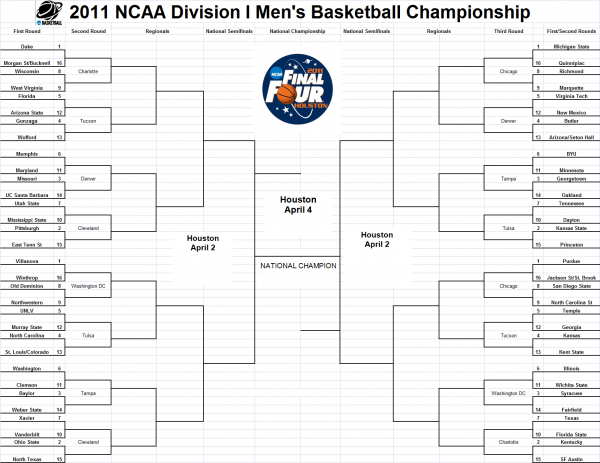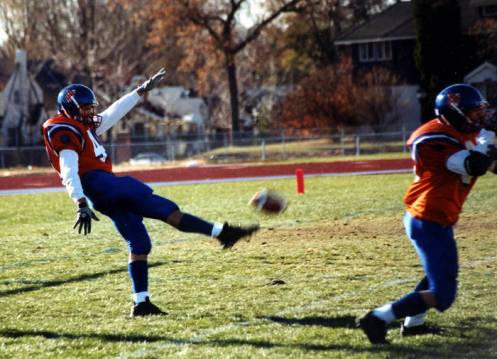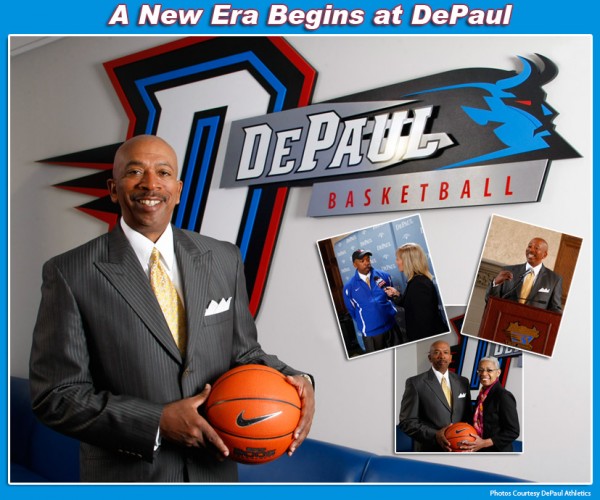Zach Hayes is an editor, contributor and bracketologist at Rush the Court.
For the entire 20 At The Top series, click here.
The Big 12 enjoyed a remarkable 2009-10 season, rivaling only the monstrous Big East for the ever-changing label of top conference in the land. Kansas spent a large majority of the season atop the national rankings, Texas escalated to a #1 spot before falling flat on their face, Kansas State was a top-ten squad that reached the Elite 8, Baylor exploded late to join K-State in the Elite 8, Texas A&M recovered from the Derrick Roland injury to put together a successful campaign, James Anderson led Oklahoma State to big wins and Missouri continued to be dangerous. With numerous impact seniors and juniors no longer residing in the conference and expansion put on the back burner, 2010-11 could be a bit of a down year in terms of elite teams and extraordinary talent. Continuing our Friday series of the top players in each conference heading into next season (my ACC top 20 from last week), here’s a look at the cream of the crop in the Big 12:
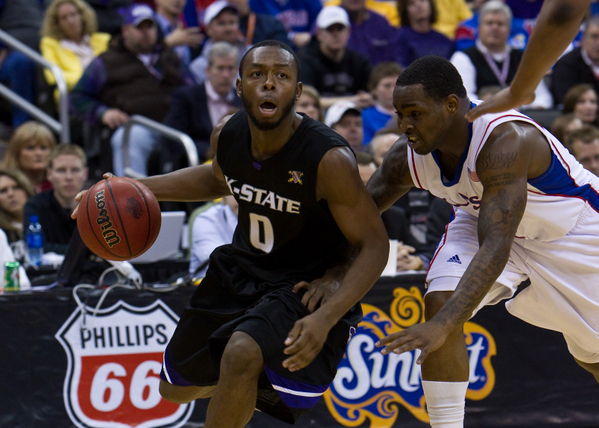
Pullen is the preseason favorite for B12 POY
1) Jacob Pullen, Kansas State– With backcourt mate Denis Clemente exhausting his eligibility, the onus is on Pullen to carry the strongest load of any team with Final Four expectations next season. I’d deduce the 6-foot sharpshooter has the chops to take on such an assignment. Pullen has an outgoing personality, displayed great leadership qualities last year and is always anxious to improve his game. His fearless shooting stroke and unlimited range really set Pullen apart. He peaked last year on the grand stage of the NCAA Tournament, scoring 62 points combined on 13-24 from behind the 3-point arc against BYU and Xavier. With Clemente no longer around to take shots, Pullen could average over 20 points per contest and put together a strong candidacy for first team All-America. The question mark regarding Pullen is his ability to run the point. He worked primarily off screens and isolations at K-State last season and will need to show more than just shooting guard skills at 6’1 to take the Wildcats to even greater heights.
2) Marcus Morris, Kansas– Assigned more of a supporting role with Cole Aldrich, Sherron Collins and Xavier Henry around, Morris and incoming frosh Josh Selby are now assigned to make sure Kansas continues to bypass any semblance of rebuilding. Despite being more of a role player, Morris managed to be supremely efficient playing just 61% of his teams’ minutes. The 6’9 forward ranked in the top-100 in offensive rating and efficient FG%. He’s also an outstanding offensive rebounder nationally where a committed Morris won’t be denied snagging key second chances. His fundamentals are constantly improving from defensive effort to a confident face-up game and even a mid-range jumper that’s showed increasing range. Scary news flash for the Big 12: there’s still plenty of room for the young Morris to grow as a player. He should be a force next season in a starring role, averaging around 18/9 per game and molding into the most dominating forward in the conference.
3) Cory Higgins, Colorado– Few college hoops fans know much about Higgins. Playing three seasons for an irrelevant Colorado team in a conference loaded with big-name, successful programs will do that to you. I expect the Buffs to make more noise nationally in this upcoming season under new coach Tad Boyle, and the biggest reason is Higgins. The talented guard averaged nearly 20 PPG and shot close to 50% from the field in a junior year where stopping Higgins and freshman Alec Burks was the game plan for every opposing coach. Higgins has a quick first step, can explode to the rim and feels comfortable drawing contact and getting to the charity stripe at an outstanding rate where he shoots 83%. One of the candidates to lead the Big 12 in scoring next season, Higgins is a name to look out for even if the Buffaloes are not able to turn their program around in 2010-11. With Higgins on his last hurrah and Burks flirting with the NBA Draft, this could be their last chance for a good while.
4) LaceDarius Dunn, Baylor– Dunn made the prudent decision to return to Baylor for his senior season for another shot at the Final Four and the chance to move his draft stock even higher. Even with a funky shooting form, Dunn can light up any gym with his remarkable scoring abilities. In fact, Tweety Carter can thank Dunn for providing him with such astounding assist totals last season. Dunn could very well be the most potent shooter in the nation in 2010-11, an athletic talent that can catch fire at any moment. Dunn’s game has, on occasion, shown its ugly side — uninterested effort on defense, three straight years of more turnovers than assists, too much of a “streetball” mentality — but overall Dunn provides more positives for Scott Drew and Baylor than negatives. With Carter and Ekpe Udoh gone and Perry Jones no lock to become Superman, Dunn will need to refine his complete game rather than just play spot-up shooter and float around the perimeter for Baylor to reach another regional final.
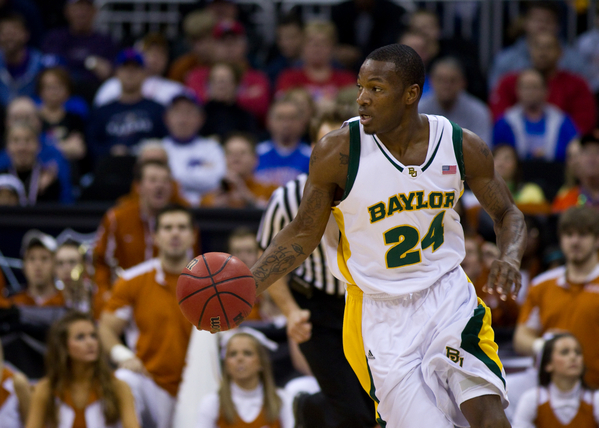
It wouldn't surprise anybody if Dunn led the B12 in scoring
5) Perry Jones, Baylor– Even if he’s around for only one season, Jones has the chance to make the greatest impact of any Bear since Vinnie Johnson was dropping 24 per game in Waco. Jones is 6’11 with a 7’2 wingspan but plays more of a Lamar Odom/Tracy McGrady-style small forward, flashing advanced perimeter skills and the ability to pull up from mid-range with confidence. He’s at his peak when attacking the basket and can be absolutely unstoppable when motivated. Jones still has plenty of growth ahead of him on the defensive end of the floor and tends to disappear without the ball in his hands, but Scott Drew has to be incredibly anxious to start working with this kid and tap into that potential. The ceiling is unlimited and Jones is a near-lock to go in the top 5 in the 2011 NBA Draft.
6) Alec Burks, Colorado– Colorado fans are probably still wondering what would have happened if Burks, who was cleared by doctors but not at 100 percent, had played with a sprained left knee in an overtime home loss to top-ranked Kansas. The ultra-talented freshman turned out to be quite the recruiting coup for former headman Jeff Bzdelik and is returning to team with Cory Higgins for a campaign that they hope ends in the Buffs first NCAA berth since 2003. Burks scored over 17 PPG, shot 54% from the field and scored in double digits in every game as a rookie. I could probably just stop there. A late bloomer to scouts and evaluators, Burks possesses solid size and athleticism for a shooting guard, can fly to the rim, flashes decent court vision and shows the stroke to be a capable outside shooter in the near future. Adding some strength this summer would suit Burks extremely well.
7) Kim English, Missouri– He’ll never put up tremendous scoring totals because of the Tigers’ system and balanced attack, but if any player can anchor the Missouri attack next season, it’ll be the poetic and tweet-loving English. Known for sleeping in the Mizzou practice facility to get shots in before class, English has the skills to explode onto the national scene as a junior. English has rarely seen a shot he didn’t like and, for the amount of times the ball leaves his hands, a 39% FG% probably needs to move up a few ticks. Still, the 6’6 Baltimore native shows impressive three-point range and plays the role of another pest in Mike Anderson’s own version of 40 Minutes of Hell.
8) Josh Selby, Kansas– Bill Self won an intense recruiting battle for the former Tennessee commit Selby, ranked nationally as one of the top high school point guards in the nation. Other than Harrison Barnes and maybe Kyrie Irving, Selby has the most responsibility on his plate from Day One in Lawrence, stepping into Sherron Collins’ shoes as the on-court leader of the Jayhawk attack. If talent is any indication, Selby should be able to handle that demanding role. Selby possesses great body control and flies to the basket, but defenders must respect his deep shooting range and Selby has the ability to pull up for a leaning jumper at any moment on the break. That quickness and explosiveness could, in some ways, be an upgrade to Collins, and three-point poppers like Brady Morningstar and Tyrell Reed will still receive plenty of open looks with Selby flying around. Even with the typical freshman lumps, he’ll likely be a double-digit scorer right away and make an immediate impact on the Allen Fieldhouse hardwood.
9) Curtis Kelly, Kansas State– A former promising Jim Calhoun recruit, Kelly has found a home in Manhattan and is thriving beautifully. He impressed me just as much as any big man in last year’s NCAA Tournament and still has plenty of room to grow and expand his budding post game. Kelly averaged 12/6 on 57% FG playing with a busy Wildcat front line, but his 21 points in their Sweet 16 marathon win over Xavier is where I saw Kelly truly shine. The lanky southpaw has a nice face-up game but can also bang low in the post and shows spurts of tremendous skill. Maintain that aggressiveness both scoring and on the boards over 30 minutes of action and Kelly could form quite the inside-outside 1-2 punch with Jacob Pullen.
10) Mike Singletary, Texas Tech– Much like Higgins and Burks, Singletary doesn’t receive much national publicity because of his team’s recent success compared to the likes of Kansas, Texas and Texas A&M. Make no mistake about it, though: Singletary can play with the best of the conference and leads a number of key returners back to Lubbock for a run at the Big Dance. Singletary first made headlines when he dropped an otherworldly 29 straight points for the Red Raiders in one Big 12 Tournament game as a sophomore. He only improved as a junior: 15.0 PPG, 6.8 RPG, 2.3 APG, but struggled with jump shot inconsistencies, making up for those off nights by living at the free throw line.
Read the rest of this entry »



































